We spent a wonderful holiday in Rome with kids, strolling through piazzas, loving the townscape in all its richness, and eating gelati while being mesmerized by those beautiful fountains. One thing that struck us though, was the number and variety of Rome’s Obelisks. – So of course I had to do some finding out and here are the results for you!
Rome is known for many things, but one of the least known facts about this historic city is that it is home to the most obelisks in the world, with 13 – five ancient Roman obelisks and eight ancient Egyptian obelisks.
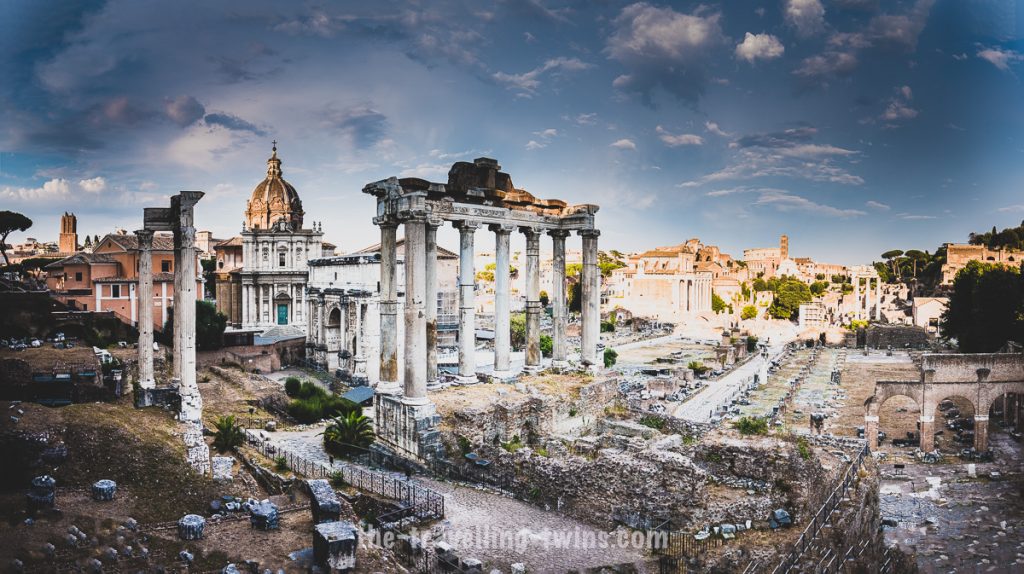
Do you want to know more about Rome? Read Interesting Facts about Rome
It may come as a surprise that Rome has even more Egyptian obelisks than the whole of Egypt, but there is a perfectly logical explanation. During ancient times, Roman Emperors were fascinated by Egypt, and at the time, the most highly sought-after treasures of their conquests were obelisks. In ancient Egypt, an obelisk was a celestial emblem of the Pharaohs. So just as the British aristocrats of the eighteenth and nineteenth-century plundered the classical world for its treasures, so did the Romans nearly two thousand years earlier.
The Romans used a type of cargo carrier known as obelisk ship to transport these prized assets across the Mediterranean to Rome, first via the Nile and then across the Sea. They would then use large cranes to erect the monuments on site.
And in addition to those 13 ancient obelisks, the city of Rome also has a number of modern obelisks.

Ancient Egyptian Obelisks in Rome
The Roman emperors took at least eight Egyptian Obelisks to Rome after their conquest.
Lateranense – Piazza di San Giovanni in Laterano
Measuring some 45.70 meters from the ground to the top, Lateranense is the tallest obelisk in the city of Rome and the largest ancient Egyptian obelisk still standing today. It is located in Piazza San Giovanni in Laterano.
It is also known as the Lateran Obelisk and dates back to 15th century BC. The monolith was built by Pharaohs Tuthmosis II and IV specifically for the Temple of Amon.
However, at around 357 AD, the Romans had learned of its existence and were planning on how to ship the obelisk to Rome. Emperor Constans II, who happened to be the son of Constantine the Great, ordered a special ship be made to help transport the monument to Rome to help decorate the Circus Maximus, Rome’s largest chariot racing stadium. In 1587, the obelisk was placed at its current location.
Vatican Obelisk – St Peter’s Square
Originally, this monument was erected at the Forum Iulium in Alexandria as per the orders of Emperor Augustus between 30 – 28 BC. However, Caligula brought it to Rome and place it in St Peter’s Square. It is now the oldest monument in the square having been elevated in the 1500s. During its erection, the workers seemed to have problems getting it into position. When they were pulling, the ropes stretched and after some tense moments, a sailor gave them hint – put water on the ropes- and that trick helped tighten the ropes and saved the day.
Today, it is the only obelisks in the city that is yet to be toppled.
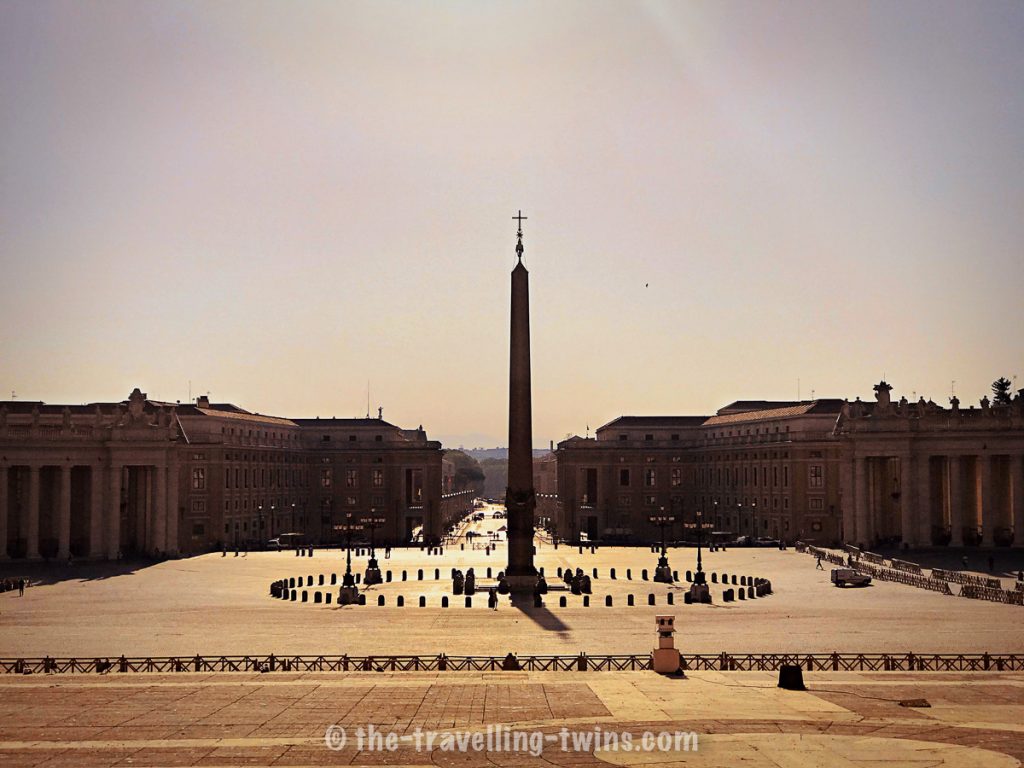
Flaminian Obelisk – Piazza del Popolo
In XIII Century BC, Flaminian Obelisk was built for Pharaoh Rameses II to decorate his Temple of the Sun. Standing 34 meters tall from the ground; the monument was moved to Rome by Augustus around 10 BC and placed in the middle of Circo Massimo. The obelisk was again discovered in 1586 in Circus Maximus (in three pieces) it got rebuild by Pope Sixtus V and placed in Piazza del Popolo. In XIX century the Egyptian-inspired lions statues in the fountain nearby symbolize the origin of the obelisks.
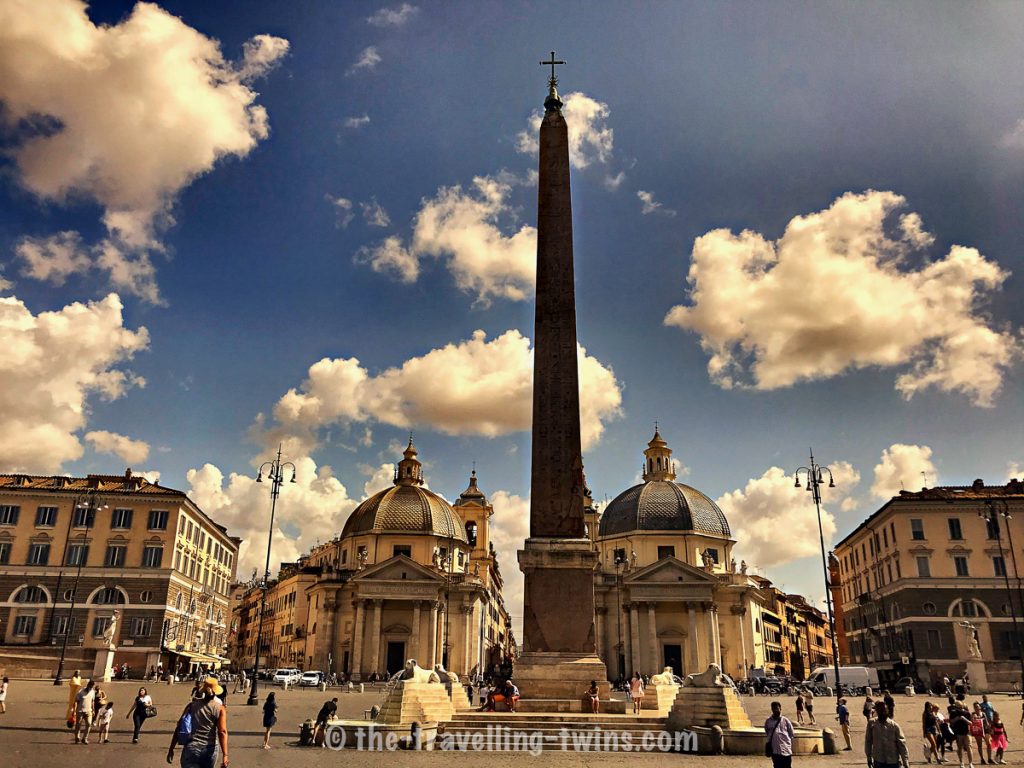
Solare Obelisk – Piazza di Monte Citorio
Built around 600 BC by Psamtikos, was brought to Rome by Emperor Augusts and erected in the Campo Marzio, Field of Mars, which served as a military training ground, where worked as a sundial. Most probably got toppled during the siege of Rome in the 11th century or obelisk fell down during the earthquake and got buried with time until excavated and re-erected in 1792 .
Solare Obelisks its know as well as Obelisk of Psammetichus II
Macuteo Obelisk – Piazza della Rotonda
Macuteo Obelisk – is the obelisk of Ramesses II. Its 6.34 meters height. It stands in Piazza della Rotonda. It is one of the pair that used to stand in front of the Temple of Re in Heliopolis – the other is Matteiano. Moved to the temple of Isis, which was located near the Basilica of the Blessed Virgin Mary above Minerva. Discovered in 1373, it was set on the eastern side of Santa Maria in Aracoeli in the Capitol. Moved to the Pantheon by Pope Clement XI in 1711 and set over a fountain designed by Philip Barigioni.
Built by Emperor Domitian in Piazza della Rotunda, this obelisk used to adorn the Temple of Isis in Egypt.
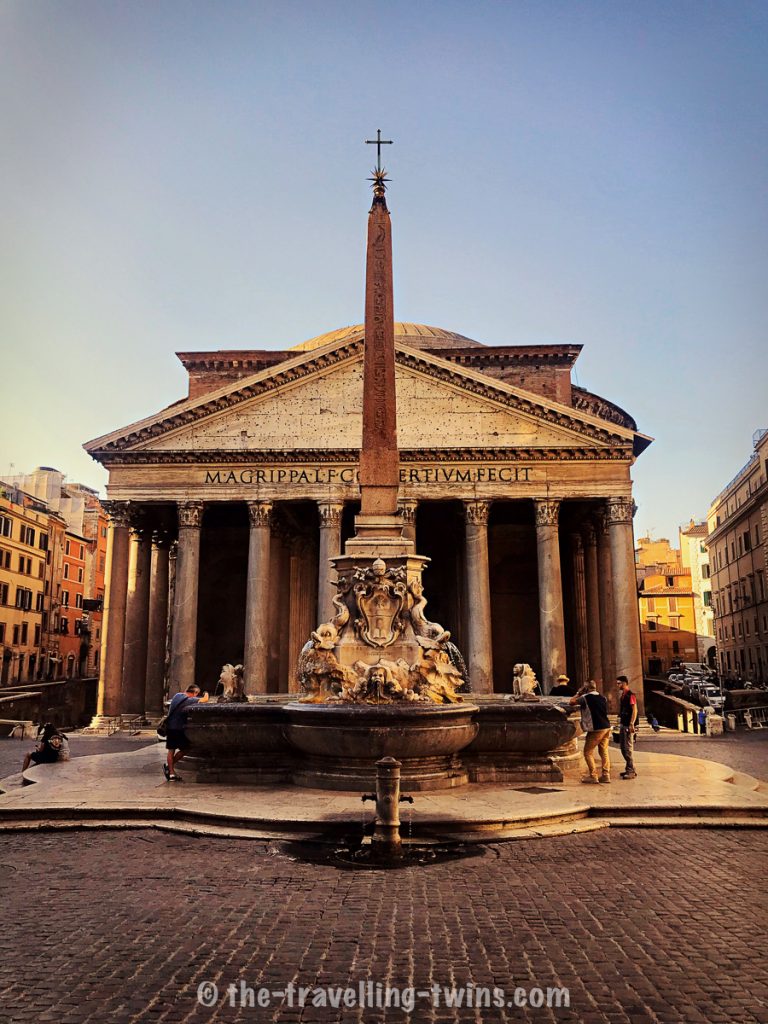

Do you want to learn more about Italy – Read Interesting facts about Italy
Minerveo – Piazza della Minerva
Minerveo was built by Apries (Wahibre Haaibre) in Sais and brought to the city of Rome by Diocletian to decorate the adjacent Temple of Sais. It was erected by Pope Alexander VII in 1667 on an elephant base near the Pantheon. Minerveo is known for being the smallest obelisk in the city of Roma with a height of just 5.47 meters.
Obelisk Minerveo – is the Obelisk of Apries. Its 5.47 meters. It stands in the square near the Basilica of the Blessed Virgin Mary above Minerva.
It is one of the pair from Sais – the other is currently in Urbino. It was brought to Rome by Diocletian to the nearby temple of Isis. Found in 1655 and in 1667, Pope Alexander VII ordered Bernini to place it in the square in front of the Church. Bernini placed an obelisk on the back of an elephant made by Hercules Ferrata.
Locals call the elephant Il pulcino della Minerva “- Minerva’s chicken”. The elephant has its bum facing the Dominican monastery as if it was showing its rump. Apparently, Dominicans complain to the Pope about the elephant but it stayed in its place.
Dogali Obelisk – Baths of Diocletian
Obelisk of Dogali Its height is 6.34 meter. It stands in the Baths of Diocletian. It was brought to Rome, to the Temple of Isis. Found in 1883 by Rudolf Lanciani near the Basilica of Our Lady above Minerva. Currently commemorates the Battle of Dogali in Ethiopia (1925).
Matteiano Obelisk – Villa Celimontana
Obelisk Matteiano – is the smallest Roman obelisk. He is the obelisk of Ramesses II. With height of 2.68 meters is the smallest of Rome’s obelisks.
Initially being half of the duo at the Temple of Ra in the ancient Egyptian city of Heliopolis. The monument was moved to the Temple of Isis close to Santa Maria Sopra Minerva but was re-erected in Santa Maria in Aracoeli on Capitolium Hill. The obelisk was then transferred to Villa Celimontana following its renovation by Michelangelo in the 16th century. Later, the obelisk was lost. The fragments, discovered at the beginning of the 19th century, were joined and placed in 1820.
Ancient Roman Obelisks
Agonalis (Pamphilius) – Piazza Navona
Obelisk Agonalis – was made by order of Emperor Domitian, set in front of the temple of Serapis. Its 16.53 meters. Moved by Maxentius to Circus Maxentius. It is standing in Piazza Navona. Set above the Fontana dei Quattro Fiumi (Fountain of the Four Rivers) by Bernini in 1651.
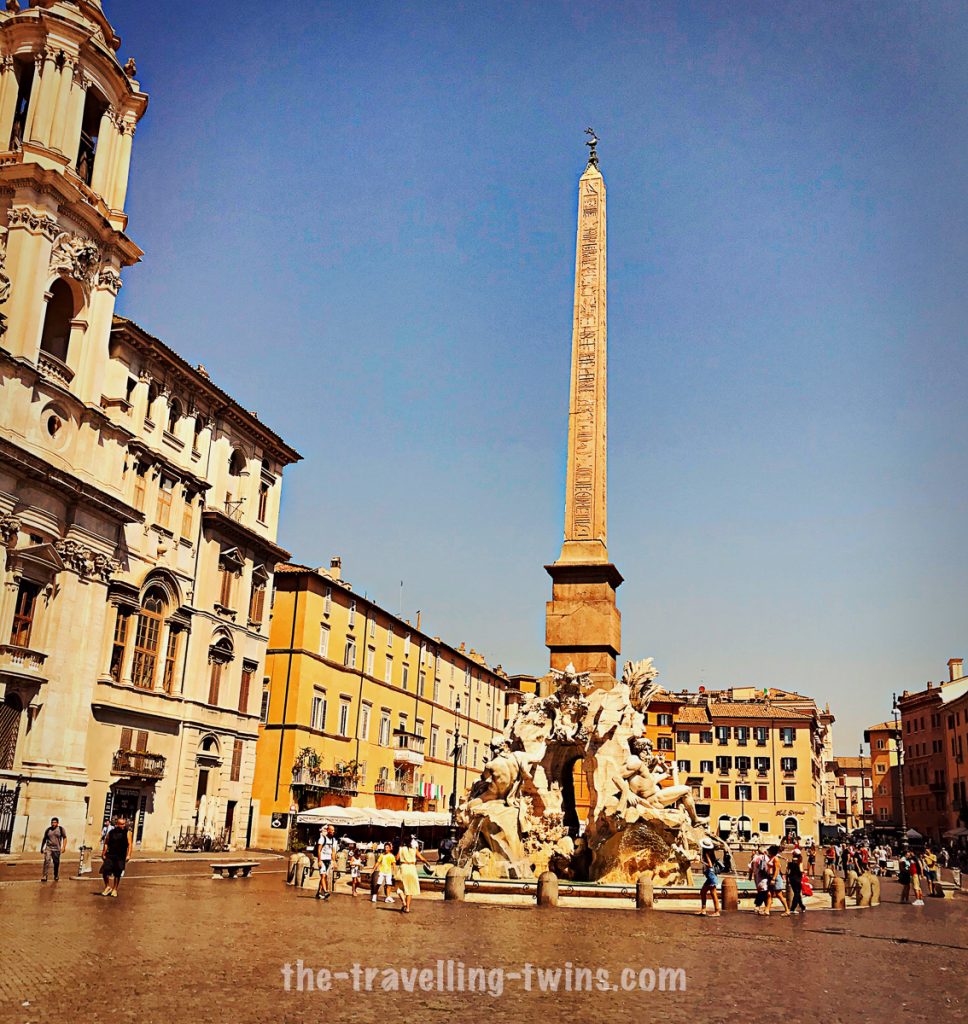
Quirinale – Piazza del Quirinale
Obelisk Quirinale was ordered by Emperor Aureliano for the Mausoleum of Emperor Augustus. Found in 1527. Set by Pope Pius VI in 1786 on the Quirinal. Its height is 14 meters 63 centimeters. It stands in Piazza del Quirinale.
Esquiline Obelisk – Piazza dell’Esquilino
Obelisk Esquiline – is an obelisk made by order of Emperor Aureliano to the Mausoleum of Augustus. Found in 1527. Set by Pope Sixtus V in 1587. It stands in Piazza dell’Esquilino behind Santa Maria Maggiore. It’s a twin obelisk to Quirinale Obelisk. Its 14,75 meters in height. It’s made from red granite and carved with fake hieroglyphics.
Sallustiano – Trinità dei Monti
Obelisk Sallustiano 13,91 meters height – is a copy (smaller than the original) of the obelisk of Ramses II Flaminio, made by order of Emperor Aureliano ( who was impressed with the Flaminio Obelisk) for the Gardens of Sallust. The top of the obelisk has a lily and a star these were heraldic symbols of Pius VI.
After it was found in 1734, it was moved to Piazza di San Giovanni in Laterano. It was not set up there but was laying down until 1789 when it was set up by Pope Pius VI. Currently, it stands on Trinita Dei Monti, above the Spanish Steps.
Pincian Obelisk
Located in Pincio Hill Gardens and close to the Flaminian Obelisk, Pincian Obelisk was once a headstone of Antinous, who died young in the Nile River while saving the life of Emperor Hadrian. But it was shipped to Rome in the 1820s.
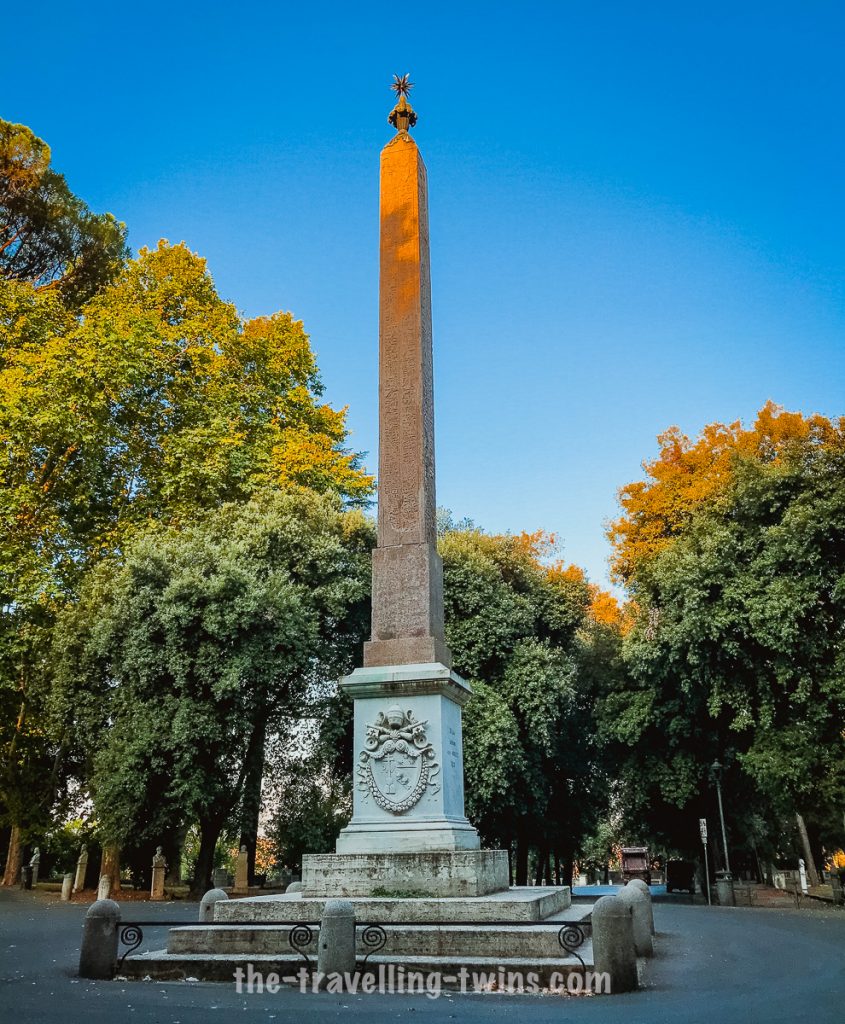
Obelisk of Aksum
The Obelisk of Aksum (23 m high) and weighing over 100 tons erected in around the 4th century by the rulers of the ancient state of Aksum in today’s Ethiopia. Its decorations imitate a nine-story building. It was most likely overthrown at the end of the 10th century and fell into five parts. In 1937, it was stolen by fascists. It stood in the centre of Rome in Piazza di Porta Capena until 2004 when it got struck by lightning. Returned to Ethiopia in April 2005 – there was a problem with the transport as the obelisk was too heavy, so it got cut into 3 pieces and restored at the original site, unveiled in September 2008
Modern Rome Obelisks
Mussolini Obelisk
This twentieth-century obelisk was erected on the order of former leader and dictator Benito Mussolini in 1932. It features the text, ‘Mussolini Dux’, which remains to this day even after the abolishment of any public reference to il Duce following the end of the Fascist system. Standing at 36 meters high, the words were believed to be too bold to be destroyed.
Obelisk of Villa Torlonia
The Obelisks of Villa Torlonia consist of two stones standing in the courtyard of Villa Torlonia and were constructed by Alessandro Torlonia in the 19th century. Both Obelisks are covered with facsimile hieroglyphics. The marbles used to build the obelisks were quarried in the northern parts of Italy and transported by boat to Rome – from the port of Venice through the Adriatic shore to the Straights of Messina, along the western shore of the peninsula, through the mouth of River Tiber, and up to his villa along the river. An operation that cost a considerable amount in terms of logistics.
Marconi Obelisk – EUR district
The obelisk was commissioned in 1939 (but finally finished in 1959) and is dedicated to Italian inventor Guglielmo Marconi. It was done by sculptor Arturo Dazzi
Rome’s Obelisks – Pin it for later!!!


